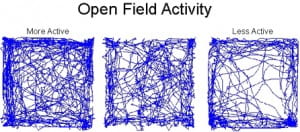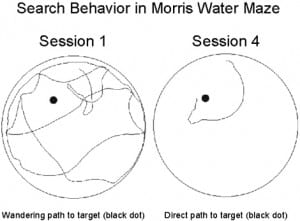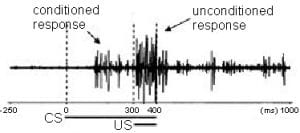Open Field Measures of General Activity and Anxiety
 The open field arena (56 x 56 cm) is used to assess ambulation levels as well as anxiety. A mouse is placed in the center of the arena and its ambulation activity is collected by the LimeLight software for five minutes. The software provides the total distance traveled as well as the percentage of time/distance within different parts of the arena. An anxious mouse will spend more of its time along the perimeter of the arena. A hyperactive mouse will have a large ambulation score. Hsiao et al. (1995, PMID: 7576662) used this task to differentiate transgenic mice carrying the Amyloid Precursor Protein gene from wild type mice. APP Transgenic mice tended to stay within the center of the cage and exhibited neophobia. Aging mice also tend to have less exploration in the open field than younger mice (Weiss, Shroff & Disterhoft, 1998). Download the OF Protocol .
The open field arena (56 x 56 cm) is used to assess ambulation levels as well as anxiety. A mouse is placed in the center of the arena and its ambulation activity is collected by the LimeLight software for five minutes. The software provides the total distance traveled as well as the percentage of time/distance within different parts of the arena. An anxious mouse will spend more of its time along the perimeter of the arena. A hyperactive mouse will have a large ambulation score. Hsiao et al. (1995, PMID: 7576662) used this task to differentiate transgenic mice carrying the Amyloid Precursor Protein gene from wild type mice. APP Transgenic mice tended to stay within the center of the cage and exhibited neophobia. Aging mice also tend to have less exploration in the open field than younger mice (Weiss, Shroff & Disterhoft, 1998). Download the OF Protocol .
Zero Maze Measures of Anxiety
 The maze consists of a round track (56 cm diameter) that is divided into four sections of equal area by two sets of walls along the track. The two regions with walls are separated by 180 degrees around the track. A mouse is placed on the track in the center of the open area and is examined for a preference for the closed or open arms. An anxious mouse will avoid the open regions of the track. LimeLight software (Actimetrics) is used to collect data for a five minute session. The software calculates the percent of time in the open or closed portions of the track. The zero maze is a recent improvement of the more common elevated plus maze; it avoids the ambiguous open/closed area at the center of the elevated plus maze (PMID: 12036108; 17805436) Download the Zero Maze Protocol.
The maze consists of a round track (56 cm diameter) that is divided into four sections of equal area by two sets of walls along the track. The two regions with walls are separated by 180 degrees around the track. A mouse is placed on the track in the center of the open area and is examined for a preference for the closed or open arms. An anxious mouse will avoid the open regions of the track. LimeLight software (Actimetrics) is used to collect data for a five minute session. The software calculates the percent of time in the open or closed portions of the track. The zero maze is a recent improvement of the more common elevated plus maze; it avoids the ambiguous open/closed area at the center of the elevated plus maze (PMID: 12036108; 17805436) Download the Zero Maze Protocol.
Y Maze Assay of Spontaneous Alternation (Working Memory)
 This arena has three arms that radiate from a central triangular area. The arms are spaced 120 degrees apart and are of identical dimensions (3.2 cm at the base and 13.5 cm at the top; side walls are 18 cm wide); the central triangular zone has 3.2 cm sides. The mouse is placed at the base of the arm forming the stem of the Y and positioned with its nose towards the center of the maze. The mouse is observed for five minutes while it freely traverses the maze. The order of arm entries is recorded and analyzed for spontaneous alternation (SA). SA is a natural, hippocampal-dependent behavior of rodents in which they tend not to repeat exploration of a region that has no reward (Douglas 1975). This behavior relies on working memory and does not require any rewards or punishments. An alternation is scored for each set of three consecutive choices where no repeated entries occur. An alternation score (# alternations / # of possible alternations * 100) of 50% indicates a random selection. Young, healthy C57BL6 mice typically exhibit scores of 75-80% alternation and aging mice approach 50% alternation (Weiss et al., 1998). The Y maze data are collected by LimeLight software. Download the YM Protocol.
This arena has three arms that radiate from a central triangular area. The arms are spaced 120 degrees apart and are of identical dimensions (3.2 cm at the base and 13.5 cm at the top; side walls are 18 cm wide); the central triangular zone has 3.2 cm sides. The mouse is placed at the base of the arm forming the stem of the Y and positioned with its nose towards the center of the maze. The mouse is observed for five minutes while it freely traverses the maze. The order of arm entries is recorded and analyzed for spontaneous alternation (SA). SA is a natural, hippocampal-dependent behavior of rodents in which they tend not to repeat exploration of a region that has no reward (Douglas 1975). This behavior relies on working memory and does not require any rewards or punishments. An alternation is scored for each set of three consecutive choices where no repeated entries occur. An alternation score (# alternations / # of possible alternations * 100) of 50% indicates a random selection. Young, healthy C57BL6 mice typically exhibit scores of 75-80% alternation and aging mice approach 50% alternation (Weiss et al., 1998). The Y maze data are collected by LimeLight software. Download the YM Protocol.
Water Maze Testing (Spatial Memory)
 This task designed by Richard Morris takes advantage of the natural swimming ability of rodents and the ease of manipulating cues around the maze. The mouse is put in a pool of water and swims until an escape platform (hidden just under the surface of the water) is found. If the platform is kept in the same position and each trial begins from a different position the mouse quickly learns to use distal cues to locate the position of the platform. On the last day the mouse or rat is tested with a probe trial, i.e., no platform is present. A subject that has learned the task well will stay more often in the target quadrant and in close proximity to the expected target location. HVS software is used to control, collect and analyze the experiment. The dependent variables to measure learning in the water maze are latency to reach the escape platform and the length of the path taken to get from the start point to the target. The percent of time exploring the target quadrant during the probe trial is also used. (See recent paper PMID: 19841742) Download the Mouse Morris Watermaze.
This task designed by Richard Morris takes advantage of the natural swimming ability of rodents and the ease of manipulating cues around the maze. The mouse is put in a pool of water and swims until an escape platform (hidden just under the surface of the water) is found. If the platform is kept in the same position and each trial begins from a different position the mouse quickly learns to use distal cues to locate the position of the platform. On the last day the mouse or rat is tested with a probe trial, i.e., no platform is present. A subject that has learned the task well will stay more often in the target quadrant and in close proximity to the expected target location. HVS software is used to control, collect and analyze the experiment. The dependent variables to measure learning in the water maze are latency to reach the escape platform and the length of the path taken to get from the start point to the target. The percent of time exploring the target quadrant during the probe trial is also used. (See recent paper PMID: 19841742) Download the Mouse Morris Watermaze.
Recognition Testing (Declarative Memory)
Object recognition is based on the preferential exploration of novel objects. A mouse is habituated to an empty open field prior to testing. It is then placed back into the open field with two identical objects and the mouse is allowed to explore the objects. The mouse is then removed and after a delay of 1-24 hours the mouse is returned to the maze with one of the original objects and one novel object. The ratio of time exploring the novel object to the total exploration time yields an object recognition index. (See PMID: 19841742)
Place recognition is measured by exposing the mouse to two identical objects and then exposing it again to the same two objects but with one of the two objects in a new area of the arena. The ratio of time exploring the novel location to the total exploration time yields a place recognition index. (See PMID: 19841742)
Social recognition is measured in two ways: 1) by placing the mouse of interest in an open field with a captive cage mate at one edge of the arena and a captive novel juvenile mouse at the opposite edge of the arena. The ratio of time exploring the novel mouse to the cagemate yields a social recognition index; 2) by exposing the mouse of interest to a novel captive juvenile mouse for two minutes and then after a delay the mouse of interest is exposed again to the same mouse. A ratio of the duration of the second exploration to the first exploration yields a recognition index. (See: PMID: 14715132) Download the NEW Novel Object Location and Recognition Protocol.
Fear Conditioning
 Fear conditioning is a well-understood associative learning paradigm from a behavioral and neurobiological perspective. It is one of the more frequently used paradigms since it is rapidly acquired and does not require surgical intervention. Animals are placed in a conditioning chamber. Each trial consists of a tone (for tone-signaled fear) followed by a brief, mild foot shock through a grid floor at the bottom of the cage. On the following day, the animal is returned to the same conditioning chamber and its movements are recorded with a video camera to test for contextual conditioning. Very low levels of movement in the training environment indicate freezing or “fear” that is associated with the context of the conditioning chamber. After the context test the animal is placed in a novel context (new visual cues, new shape, new odor, no grid floor) and tested for cue-signaled fear by presenting the original conditioning tone. Freezing in response to the tone indicates a conditioned fear response. This behavior requires the amygdala and has been shown to be hippocampally-dependent when the initial conditioning trials contain a 30 sec trace interval between the offset of the tone and onset of the shock (See PMID: 16420434). The experiment is controlled by FreezeFrame 4 software and analyzed with FreezeView software (Actimetrics). Download the Fear Conditioning Protocol.
Fear conditioning is a well-understood associative learning paradigm from a behavioral and neurobiological perspective. It is one of the more frequently used paradigms since it is rapidly acquired and does not require surgical intervention. Animals are placed in a conditioning chamber. Each trial consists of a tone (for tone-signaled fear) followed by a brief, mild foot shock through a grid floor at the bottom of the cage. On the following day, the animal is returned to the same conditioning chamber and its movements are recorded with a video camera to test for contextual conditioning. Very low levels of movement in the training environment indicate freezing or “fear” that is associated with the context of the conditioning chamber. After the context test the animal is placed in a novel context (new visual cues, new shape, new odor, no grid floor) and tested for cue-signaled fear by presenting the original conditioning tone. Freezing in response to the tone indicates a conditioned fear response. This behavior requires the amygdala and has been shown to be hippocampally-dependent when the initial conditioning trials contain a 30 sec trace interval between the offset of the tone and onset of the shock (See PMID: 16420434). The experiment is controlled by FreezeFrame 4 software and analyzed with FreezeView software (Actimetrics). Download the Fear Conditioning Protocol.
Eyeblink Conditioning
 Eyeblink conditioning is a well understood associative learning paradigm from a behavioral and neurobiological perspective. Typically a tone is presented with a mild shock near the lateral edge of the eyelids. The subject eventually learns to blink in response to the tone and prior to the onset of the mild shock. Several sensory systems can be used for the conditioning stimulus (sound, light, whisker vibration).
Eyeblink conditioning is a well understood associative learning paradigm from a behavioral and neurobiological perspective. Typically a tone is presented with a mild shock near the lateral edge of the eyelids. The subject eventually learns to blink in response to the tone and prior to the onset of the mild shock. Several sensory systems can be used for the conditioning stimulus (sound, light, whisker vibration).
Eyeblink conditioning in mice and rats requires the cerebellum (and its associated circuitry) and the hippocampus and other forebrain structures when a 250 ms trace interval separates the conditioning stimulus from the uncondioned stimulus (See PMID: 15058483 and PMID: 10512579).
Conditioning is done in an Industrial Acoustics sound attenuating chamber containing four smaller chambers to train up to four mice at one time. The timing of the conditioning and unconditioned stimuli is controlled by a computer coupled to stimulus delivery modules and the computer collects eyelid EMG activity or an optical signal that represents the blink. This task requires a relatively simple surgery to implant microwires into the eyelid to record EMG activity or to secure an optical blink transducer.
Gait Analysis and Rotorod Testing
 The DigiGait system of automated gait collection and analysis provides objective quantification of several gait parameters (PMID: 19516084). Mice are taken one at a time and placed inside the DigiGait enclosure surrounding a portion of a transparent treadmill. The treadmill is activated and electronic “footprints” of the mouse are collected by a high speed video camera that is mounted underneath the treadmill. Data are collected during ambulation at a few different speeds ranging from 10-20 cm/sec. A 3-5 sec sample of data provides enough strides to determine the characteristic gait parameters (e.g. stride length, width, angle) of the mouse. Download the Digigait Protocol or Rotarod Protocol.
The DigiGait system of automated gait collection and analysis provides objective quantification of several gait parameters (PMID: 19516084). Mice are taken one at a time and placed inside the DigiGait enclosure surrounding a portion of a transparent treadmill. The treadmill is activated and electronic “footprints” of the mouse are collected by a high speed video camera that is mounted underneath the treadmill. Data are collected during ambulation at a few different speeds ranging from 10-20 cm/sec. A 3-5 sec sample of data provides enough strides to determine the characteristic gait parameters (e.g. stride length, width, angle) of the mouse. Download the Digigait Protocol or Rotarod Protocol.
Tactile/Pain Sensitivity
Rodents exhibit a paw withdrawal reflex when the paw is unexpectedly touched. The animal indicates sensation by pulling back its paw.
Touch sensitivity is assessed with von Frey filaments. These filaments are applied to the underside of the paw after the mouse has settled into a comfortable position within a restricted area that has a perforated floor. The filaments are calibrated to flex when the set force is applied to the paw. (See PMID: 19628434, PMID: 18513322)
Pain sensitivity is assessed with a thermal plantar device. An infrared beam is applied to the base of the paw as it rests on a glass plate. When the rat feels pain and withdraws its paw, the I.R. source switches off and the reaction time counter stops. The withdrawal latency is automatically determined. Download the PLANTAR Protocol.
Startle Response and Prepulse Inhibition of Startle
A startle response is a whole body response to a loud aversive stimulus. In the prepulse inhibition (PPI) procedure, the rodent is placed in a small chamber and exposed to a brief pulse of noise. A weak acoustic stimulus (i.e., the prepulse) decreases the reflexive flinching startle response produced by a second, more intense stimulus (the pulse). The test is used to assess the subject’s ability to “gate” or filter environmental information.
Prepulse inhibition is a cross-species phenomenon (ie, it is present in mammals ranging from mice to humans), yet it is relatively absent among schizophrenic patients and among patients with Alzheimer’s disease. The reduced ability to filter out irrelevant auditory stimulation is a characteristic thought to contribute to certain manifestations of these conditions including inattention, distractibility, and cognitive deficits. The test is useful for evaluating transgenic models of schizophrenia as well as to screen potential antipsychotic drugs. (See PMID: 9298514, PMID: 2292046, PMID: 18428548) Download the Startle Reflex Protocol.
Grip Strength Meter
The Grip Strength Meter determines the maximum force displayed by an animal in fore-limbs, hind limbs, or all 4 limbs. The technique exploits the rodent’s instinct to grip and pull against force. The rodent is held by the tail and then made to grip the attachment as the user slowly pulls them back until the rodent lets go. The test is commonly used to assess the effects of drugs and toxins as well as muscular and neurodegenerative diseases on rodents’ neuromuscular function. (See:Grip_Reference1 Grip_Reference2 Grip_Reference3) Download the Grip Meter Protocol.
